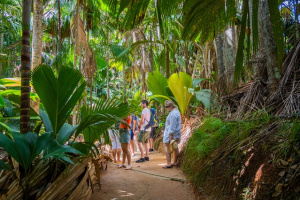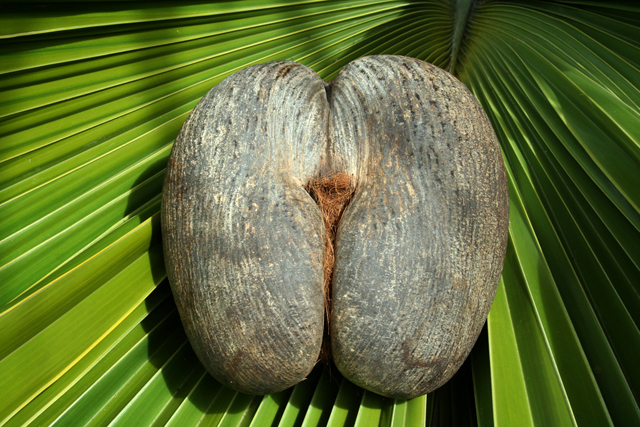7 facts about coco de mer in Vallee de Mai: Celebrating 40 years as UNESCO site
Seychelles Buzz |Author: Sharon Ernesta | December 9, 2023, Saturday @ 07:15| 181330 views
(Tourism Seychelles)
(Seychelles News Agency) - The coco de mer is the world's largest nut, and is endemic to Seychelles, a group of 115 islands in the western Indian Ocean. It grows naturally only on two of Seychelles' islands, Praslin, and its neighboring Curieuse island – terrestrial and marine parks.
On Praslin, it is found mainly at the Vallee de Mai special reserve, which is one of the two island nation's UNESCO World Heritage sites, as well as at the Fond Ferdinand reserve. The other site is the Aldabra Atoll where the famous Aldabra giant tortoise is found.
The coco de mer is listed as an endangered species by the International Union for Conservation of Nature (IUCN). As the Vallee de Mai celebrates 40 years since its dedication as a heritage site on December 9, SNA brings you seven fascinating facts about the coco de mer and the nature reserve.
Vallee de Mai – "pre historical" reserve
Vallee de Mai reserve has a palm forest which has remained largely unchanged since prehistoric times. This mysterious forest first received national protection in 1966, when it was declared a nature reserve by the government. Dominating the landscape is the world's largest population of endemic coco de mer palm, a flagship species of global significance as the bearer of the largest seed in the plant kingdom. The forest is also home to five other endemic palms and many endemic fauna species. A little over 19 hectares, the Vallee de Mai is one of the world's smallest natural UNESCO World Heritage Sites.
 |
| (Gerard Larose) Photo License: CC-BY |
Myth, legends, and mysteries of the Coco de Mer
The Coco de Mer palm is dioecious, meaning there are separate male and female trees, each with its unique reproductive organs – the male's phallic catkins and the female's large, rounded fruit. A Seychelles legend says that during a full moon, and others say during stormy nights, the coco-de-mer trees walk around the forest to mate. According to the legend, male trees uproot themselves and approach female trees. That is how they produce their erotically shaped "love nuts."
 |
| (Gerard Larose) Photo License: CC-BY |
The coco de mer – the king of palms
The coco de mer palm is amongst the oldest and tallest palms in the world, with claims that these can be up to 800 years old. The leaves of the palm can measure up to 6 meters long and 3.5 meters wide. The coco de mer leaves hold a remarkable lifespan of over 50 years, perhaps the longest lifespan of any leaf in the plant kingdom.
The enormous, fan-shaped emerald green leaves are, at 5-8 metres in length and 3 meters in width, the largest in the vegetable kingdom. Its enormous fruit which is the largest in the plant world. The fruit takes between 6 to 10 years to mature and is generally two-lobed but may have four or even six lobes. It typically reaches a size of 40–50 cm in diameter.
The fruit of the coco de mer typically weighs between 15 to 30 kg. The largest fruit recorded weighed 42 kg, making it the world's heaviest nut. The seeds need two years to germinate, and the plant must grow 20–40 years to start flowering. It is reported that a coco-de-mer palm can support up to 180 kg of nuts at a time, with the growing nuts shaped like an enormous green heart.
 |
| (Gerard Larose) Photo License: CC-BY |
Coco de mer, the nut from the sea
The story goes that in ancient times, sailors observed large nuts floating at sea and named them coco de mer, French for 'coconuts of the sea'. Portuguese explorer Ferdinand Magellan, who led the first expedition that circumnavigated the world (1519-1522), observed and recorded the presence of these floating nuts during his voyage. They were also washed up on beaches as far east as the Maldives, India, and Sri Lanka.
 |
| (Gerard Larose) Photo License: CC-BY |
Vallee de Mai, the Garden of Eden?
In the Victorian era, British General Charles Gordon arrived on Mahe Island, the main island of Seychelles on September 11, 1818, aboard the Godavery ship, to assess the defensive measures of the Seychelles Islands in the event of an enemy attack. General Gordon visited the island of Praslin and believed that the Vallee de Mai was the original Garden of Eden as described in the Bible and that the coco de mer was the forbidden fruit of the tree of the knowledge of good and evil mentioned in Genesis 2:9, 2:17; 3:6.
Special recognition for two Coco de Mer nature reserves
The two nature reserves on Praslin island - Fond Ferdinand and Vallee de Mai – where the coco de mer grows in its natural state won the TripAdvisor 2023 Travellers' Choice Awards. The coveted award celebrates destinations that have consistently received great traveler reviews on TripAdvisor over the last 12 months, placing them among the top 10 percent of all listings on the platform globally.
The Vallee de Mai Special Reserve also won the 2023 Experts' Choice Award, an accolade based on professional reviews. Experts' Choice Awards are based on more than one million reviews from travel guides, magazines, newspapers, and other respected sources and less than 2 percent of venues and attractions globally receive an award.
 |
| (dronepic, Flickr) Photo License: CC BY 2.0 |
The most visited site of the island archipelago
The Vallee de Mai nature reserve is the most-visited natural site in Seychelles and was heavily impacted by a downturn in travel due to the COVID-19 pandemic. In December 2020, the Seychelles Island Foundation said the site saw a 97 percent drop in visitors, amounting to a $2 million loss in direct revenue. In 2022 Vallee de Mai welcomed 106,356 visitors.
Back
